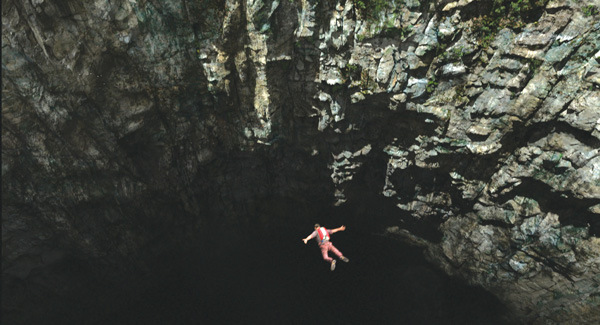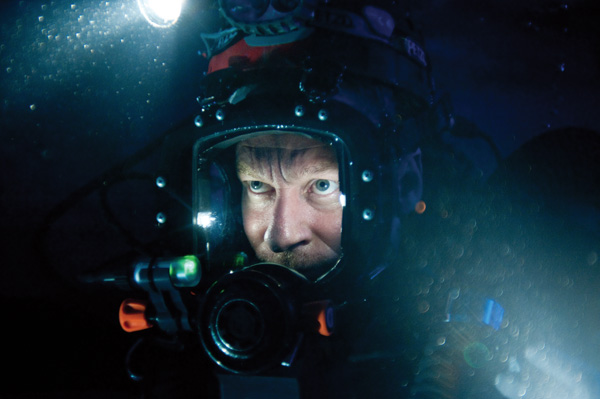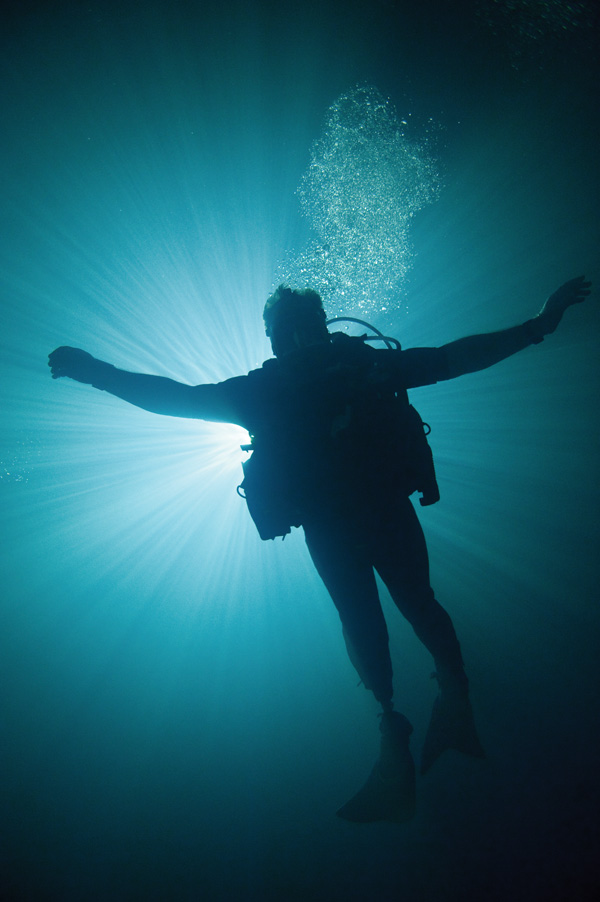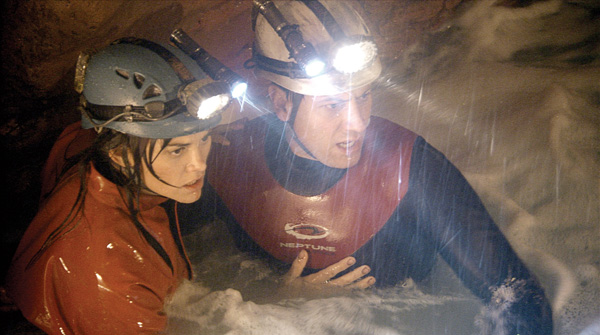|
Setting the Stage
Elaborate CG work was required in the sequence early in the story that, from the audience's point of view, helps set the stage for the environments in the rest of the film, when young Josh and his father's financier Carl step out of a helicopter at the Esa-ala Caves' entrance. A small section of the cliff face was built for the actors to stand on while they talked and prepared their gear, but the remainder is digital – plants, rocks, birds. Achieving a complete, coherent environment and communicating the vast space dropping away below the actors without looking artificial, needed correct stereo alignment combined with very accurate interior detail of the walls. Once complete, its looks also had to match the CG sink hole they had created in the aerial shots from the helicopter during the characters' approach.
A later sequence in which Frank and Josh struggle from the interior of the caves and find themselves at the bottom of a massive, deep hole open to the surface required the 3D team to build an almost completely CG environment except for a decaying, abandoned Japanese tank and a tiny set for the actors to stand on next to it. In some shots even the tank was CG. Again, showing the hole's huge size, as well as creating the rough, vertical, overgrown walls to communicate the impossibility of escape for the two characters at this point in the film, were the team's challenges.
Sunless Sahara
The 'Sunless Sahara' environment, as the VFX team called it, was possibly the largest and most challenging of the cave set extensions the team had to create. It involved unusual subterranean sand dune formations that may occur when such caves are repeatedly flooded, although lack of exposure to wind makes their looks somewhat different to dunes at the surface. They used a terrain building software called WorldBuilder to help them envision how an eroded dune might look instead, and then finished modelling from there to achieve the composition necessary for the shot.
A number of CG doubles were needed to replace characters at certain moments. For example, although the actor playing Carl did leap out into the space over the doline, requiring wire removal, from that point a digital double replaced him in a shot showing him descending under a CG parachute. Some body doubles were also used in underground caving sequences, especially looking down narrow shafts at climbers with their headlamps switched on and some of the divers underwater in scuba gear. Fortunately, none of these were at close range, so facial detail wasn't required, and performances were fairly generic and didn't need motion capture. The artists started with standard human models and then worked with photos of the cast to customise their proportions and colouring.
Props and Creatures
They also built all kinds of props - scuba tanks and rebreathers, cavers' helmets – all exactly matching similar gear used on set. Some actual gear was brought into the studio to augment the photos taken on location. When one of the actresses abseils disastrously down a cliff face, not only did her body have to be modelled but the rope she hung from had to be animated convincingly to replicate the way it would react to her movements.
A few environments nearer the surface needed the addition of CG creatures. CG bats were added to the Belfrey set, for example, and swallows flew through the doline catching insects. These animals helped complete the authenticity of the upper cave system environments. Flocking algorithms helped them distribute large populations of birds or bats, combined with some hand animated individuals to add interest and variety as they took off or landed. "Our cave swallow references included their small mud nests, which we built clinging to the walls and rocks. These creatures, I think, really help the shots to work and feel alive for the viewer."
Underwater World
The Iloura team were often called on to help enhance or provide continuity for the many scenes shot underwater. A reconfigurable set piece, similar to a labyrinth, was built and used submerged in the tank facilities at the Warner Bros Gold Coast studios, and a few shots were captured in some actual underwater caves. All the divers seen were shot live action except for a few distant figures in very wide shots. The long, sustained sequence at the very end of the film as Josh swims with his tiny air tank out of the cave to the surface and freedom, was also all live action, carefully edited together.
Particulate matter was often important in the underwater sequences to give the audience a constant feeling of the presence of water surrounding the action, but couldn't be uniformly applied. On Andrew's advice that water in undisturbed underground caves is typically crystal clear, the sequence shot at St Jude's Cathedral for example contains very few particulates, but they used them at other times to avoid the look of divers floating in space. These water effects, plus grading in Nuke to control the lighting, also helped provide continuity from shot to shot as sequences were edited.
Underwater green screen was used in some cases to take people from the set to a bigger environment. This can be tricky to work with because the water contaminates the colour of the characters and of the screen equally with blue, making them more similar. What the artists actually rely on for keying is the difference between the screen and the characters. As well as lighting, the water has to be filtered and temperature controlled for consistency.
Digital Roller Coaster
At the start of the movie, Josh and Carl are shown a digital fly-through of the amazingly complex and convoluted Esa-ala Caves system on a computer screen before they embark on their fateful adventure. It was worked into the story to help the help the audience understand the nature of the environment they were entering. The camera passes through the chambers and tunnels as if on a roller coaster, revealing a simply rendered view of the exact cave system in which the story unfolds. "This fly-through was one of the first things we did on the film," Peter said. "It was fun, and formed the basis of the cave structures we used in our effects and environments work."
The stereo aspect of the project combined with the fact that this was their first project creating and working with assets and CG environments at such a large scale and with such unusual, even fantastical designs, made this project a significant challenge for the facility. Peter estimates he spent at least five to six months researching before any shots arrived at Iloura, followed by six to seven months of actual production. The knowledge and experience they have gained seems to be paying off, and they are now working on another stereo project.
|
|
Stereo Editing
Working with the stereoscopic aspect of this project was an ongoing issue for the editors of 'Sanctum'. First Assistant Editor Ben Joss explained that although they successfully managed to review their work on JVC passive stereo monitors using circular polarised glasses, as in the RealD cinema system, the footage had to be cut with the left and right images on the timeline using the right eye as their 'master' eye.
To make the monitoring work, Ben had to get the left and right eye into their Avid system. The footage was digitized straight off the HDCAM SR deck onto their Avid system as HdDNX36 MXF media, one eye at a time. The recorder put both images onto the same HDCAM SR tape into separate streams, a format Sony calls 422x2. They edited the film first on the right eye, and assistants conformed the left eye to match it afterwards. Because the left eye had been digitized already, they didn't need to return to the tapes, but simply treated it as separate media.
It was Ben's naming convention for left and right media that allowed Editorial to establish the stereo set-up in the Avid after completing the right eye edit. He exported the EDL, used a text editor to find and swap the names of the files to denote the left eye, and re-imported it into the Avid. Once it had the left eye component, it would pick up the correct files and carry out the process.
In turn, the only way to show a 3D image in the JVC monitor was to adopt a side-by-side arrangement in the Avid. They took the right eye image, reduced it down vertically 50% and moved it to the right, did the same with the left eye, moving it to the left. The monitor could then interpolate this into an interlaced image.
Phasing
"We used the right eye as our master eye because it wouldn't have passed through the beamsplitter and was slightly better quality, and did the same with the side by side rig footage," Ben said. The left eye from the beamsplitter was also inverted, or flopped, back to front. To flip it into the correct position and give consistency between the two streams, they used a device called the Stereo Brain when digitizing the footage into the Avid. Digital Pictures, responsible for the digital intermediate, grade and deliverables for the movie, had sourced this equipment for them.
As the editors worked on the film through the various passes, they sent the EDL to the Technical Director at Digital Pictures, Nic Smith, who would update the timeline and use it to conform the footage for the DI on their Lustre suite. From the Lustre, the VFX team extracted the clips they needed to work on as DPX files in separate left and right passes.
Digital Pictures soon discovered a phasing problem between the two versions, in which the time code sometimes varied between Iloura's version and the editor's EDL. In a number of cases, this appeared to have been caused by not giving the deck enough pre-roll time when digitizing the footage into the Avid, although some other shots with plenty of pre-roll showed the same problem. Nevertheless, the camera crew aimed to allow at least 5 seconds pre-roll before the action but in reality, action on set often occurs right after the camera rolls, so this could be difficult to manage.
QuickTime Check
It was critical that Digital Pictures was creating the exact same film represented by the QuickTime that Ben exported for them. He exported both eyes as QuickTimes, which they matched their output to, regardless of what the time code said. Fortunately, the discrepancy could be corrected visually and because they were working on tape, not film, the error wasn't overly costly to correct.
Creatively, the main challenge was the linear nature of the story written for 'Sanctum'. As a result, their capacity as editors to shift story elements around or change the focus was very limited. To heighten the sense of claustrophobia in the tight spaces, for example, they simply had to rely on the DoP to supply the appropriate shots and work with those.
Although the Avid does have a stereoscopic menu, they didn't actually use any of its features. "For example, there's a setting for the type of stereo footage being dealt with – side by side, up and down, interlaced, anaglyph and so on, plus your preferred viewing format," Ben explained. "But while stereo footage involves two discrete images, the Avid wants these to have been combined in some format, before it interprets it for viewing. On the client monitor, it will always show both left and right images but on the internal monitor you can select different displays. Also, if you want to use correction tools to adjust conversion or blow up a shot, none of the available effects tools work. You would need to have both images there and treat them separately.
Discrete Images
"So although we could review the footage in 3D on the JVC monitor, we always had to have both, discrete left and right images there on the timeline to do any editing, which would then happen simultaneously. Initially we did try editing with a combined stereo image, alongside the right eye on its own, with the side by side image the Stereo Brain allowed us to produce. But it wasn't of a high enough quality to output a 3D version from the Avid for their preview screenings.
The side by side image also had to be rejected because, if they wanted to review in 3D, it wouldn't maintain effects such as speed ups, slow downs, re-size, re-position or titles after splitting into left and right for monitoring. Nor could they fix the convergence on this side by side version. Thus, the left eye had to be digitized discretely, to keep both eyes on the timeline. Ben said, "James Cameron was impressed that we could review our work in 3D on our monitor, which is something he hadn't been able to do for 'Avatar'. He did warn us about the timeline problem, though. He visited the shoot and received dailies each day on DVD in 2D."
|
STEREOSCOPIC RIGS
Both beamsplitter and side-by-side rigs, two of each, were used in the production. The two types of rigs had different advantages and shortcomings. The beamsplitter is larger and bulkier and produces an inverted left eye image, but it places the cameras one above the other, thus allowing an interocular distance of as small as 0 if required, making it useful for close up shots.
The side by side rigs are more compact and both left and right eye images are oriented correctly, but the I/O distance is larger and less controllable. Typical interocular distances during production were about 2.5cm on the beamsplitter and 6.5cm for the side by side.
Consequently, while the side by side rig was chosen for underwater work because it was smaller, and given underwater housing for the diving sequences, close-up shots were a challenge and needed fixing in post.
As mentioned earlier, David developed a compact beamsplitter rig in underwater housing, employing two DSLR cameras to overcome the side by side rig's wide convergence angle that prevented close up shots underwater. David also ensured the rig would be synchronous. He successfully constructed a rig of the required size configured to hold two Nikon D3S cameras, and Nikon helped by modifying the cameras to be synchronously operated. Simon Christidis, the underwater cameraman, made the housing and controllers. The camera was quite successful and David experimented with it on some of the shots, but unfortunately they were not used in the film, mainly because the MPEG 4 image quality was considerably different to the HDCAM footage shot on the Sony CineAlta for the rest of the movie. But it worked well and when James Cameron visited the set and saw it, he was impressed by its potential for future productions.
|






















